9
Derricks were used in the quarry for lifting the great blocks of stone. A complex series of pulleys, wires and blocks enabled the chunks of stone, bound in chains, to be lifted to slovens (flatbed, heavy duty wagons) which ran on narrow gauge tracks; these were pulled by horses walking between the rails. The blocks often weighed 5-7 tons. The masts had wood 'steps' attached, enabling a man to climb up and grease the pulleys to keep things running smoothly. He would sometimes show off by standing on the top!The slovens had a low bed, which made them more stable and easier to load and unload.
10
Quarry Masts, Wallace, Nova Scotia, CanadaLate 1800's
Wallace, Nova Scotia, Canada
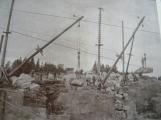 Credits:
Credits:The Flynn Family, Wallace
11
In 1885 the quarry was sold to G.P. Sherwood & Co., also the president of Dorchester Union Freestone Company. The two companies shipped stone up and down the United States east coast and Canada.Then, in 1912, Lyall & Sons purchased the quarry, modernizing it with a steam mill, electric crane, and steam shovels. They continued quarrying under the name Wallace Sandstone Quarries Ltd, then finally Wallace Quarries Ltd.
12
Wallace Gravity Train Model, Wallace, Nova Scotia, Canada20th Century
Wallace, Nova Scotia, Canada
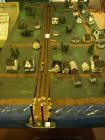 Credits:
Credits:Wallace and Area Museum
13
A gravity railroad was installed in Wallace to take the extracted stone down to the wharf to be loaded onto ships. It was finally removed in 1936. Barriers were place at each street crossed by the rail track; these barriers dropped down each time a trolly load of stone came down the hill and when an empty one went up. A semaphore signaled when a trolly was ready to go up or down the hill, which was every 20 minutes.14
Quarry Horses and Rail, Wallace, Nova Scotia, Canadaapprox. 1910
Wallace, Nova Scotia, Canada
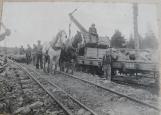 Credits:
Credits:Flynn Family, Wallace
Ellen Millard ( 'Wallace Then and Now' )
15
Twin tracks ran from the quarry down an incline to the wharf. Cables attached to slovens allowed one to go down the slope, while an empty sloven was hauled up the other side. A man at the drum at the top of the incline controlled the speed by means of a brake. Once at the wharf, a crane unloaded stone onto a schooner.The building of the Short Line railway, which ran to the south of Wallace, was important; a spur railway line linking the quarry to the Short Line railway meant that stone could be more readily transported by rail across Canada and the States.
16
Rail Link to the Wharf, Wallace, Nova Scotia, Canada1890's
Wallace, Nova Scotia, Canada
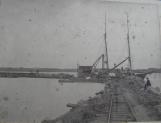 Credits:
Credits:Wallace and Area Museum
17
The wharf was obviously vital to the quarry, and the gravity rail link was more practical than the old horse drawn wagon system. The unloading of stone and the hoisting onto waiting ships became more efficient.18
Advertisement for Battye Bricks, Wallace, Nova Scotia, Canada1902
Wallace, Nova Scotia, Canada
 Credits:
Credits:Wallace and Area Museum
19
The Battye Brothers started a brickworks not far from their riverside quarry. The bricks won prizes at the Nova Scotia Exhibition and the business was obviously successful until destroyed by fire. The brick works were never reopened.20
Local Whetstone, Balfron, Nova Scotia, CanadaEarly 1900's
Tatamagouche, Nova Scotia, Canada
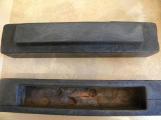 Credits:
Credits:Creamery Square Heritage Centre
21
The area around Tatamagouche had various small quarries, supplying local needs .The abutments for the railway bridge at Tatamagouche and other bridges at Waugh's River and Big Brook nearby were made from stone quarried from the east side of Waugh's River, where it was raised by a horsepower capstan and derrick. When Roy Kennedy was writing in the 1980's, an adjacent field was called 'Quarry Field'.
Stanley Jollimore (now deceased) explained how blocks of stone were loaded onto a wagon; a winch was located in the center of the wagon and the space below was covered with 3 inch (8cm) thick planks. By removing these, a space was left; the wagon was driven over the block which was winched through the space onto the wagon. The wood planks were replaced and the stone was loaded.
Other quarries in the Waugh's River area were on the Black Brook, a short distance below the bridge on the road to Keble.
A fine grey sandstone used in the making of grindstones was found near the schoolhouse at Balfron, on Chambers Brook (Yellow Brook) at Waugh's River. Logan Murphy of Balmoral and his sons manufactured grindstones for many years until 1941.
The grey sandstone was also excellent for whetstones.
Quarries in this area tended to be small and scattered. Before cement came into common use, ground-up quarry stone was used in the construction industry for bridge piers, foundations, and abutments. A 1905 Geological map shows nine quarries in North Colchester; most were where erosion had exposed horizontal beds of sandstone along various streams and rivers. One was on the shore at Weatherbie's Point. The best quarries were above Campbell's Bridge on the French River at Tatamagouche. The water here was deep enough to transport the quarried stone.
In his book 'Days of the Ships', Frank Patterson refers to the 53 ton schooner 'Margaret Ann', built by William Buckler in 1880, as transporting quarried stone from the French River to Boston. At this time there was sufficient clearance beneath the bridge for tall-masted vessels, and some could lower their masts. The construction of the 1885 railway with the rail bridge over the river, stopped this traffic.
A short distance upstream on the French River was another quarry, near the home of a D. R. Bell.
Oral evidence collected by Roy Kennedy, possibly in the early 1980s, reported Ramsey's Quarry, not far above the junction of Mill Brook and French River, on the eastern side. It seems that there was a copper mine at the same site, mined earlier by Abraham Patterson. Since that time erosion has removed much of the site.
Another small quarry was ½ mile (0.8 km) downstream, on the east bank of the French River and owned by William Glenn. Stone quarried was raised up a cliff by a derrick and hauled to the New Annan road and then to markets. Some stone seems to have been sent downriver to Tatamagouche, and it is possible that the abutments for one of the local bridges came from this quarry, which was still worked at the turn of the 20th Century.
None of the quarries on the French River were operating before 1844.
There was a small quarry on Millbrook on the former Allison Swan property, where a hill of red sandstone was quarried for local use. There were two other small New Annan quarries suppling stone for local chimneys and building foundations, including the McLeod School (most of the schools were built after 1865, suggesting the quarries were working around this date). The stone was of excellent quality and easily worked; although the output was small. It played an important part in the local communities.
Another quarry at Bayhead, was opened about 1850-60, but the quality was poor and when a major quarry producing building stone of high quality, started at Wallace in 1866, it was no longer worked.
22
Two Runner Stones of Wallace Sandstone, Balmoral, Nova Scotia, Canadamid 1800's
Balmoral, Nova Scotia, Canada
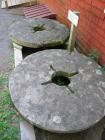 Credits:
Credits:S. Brinkhurst